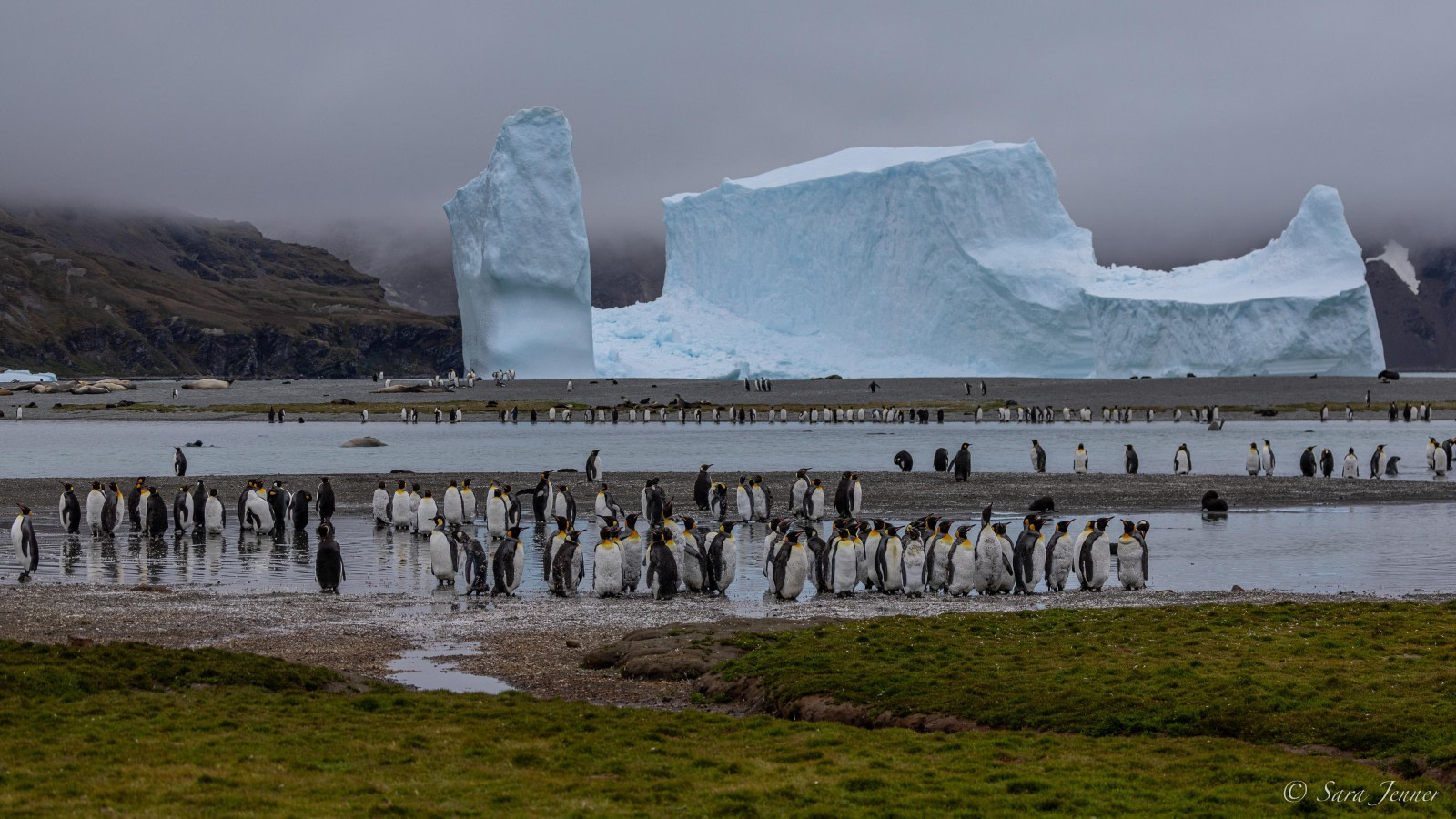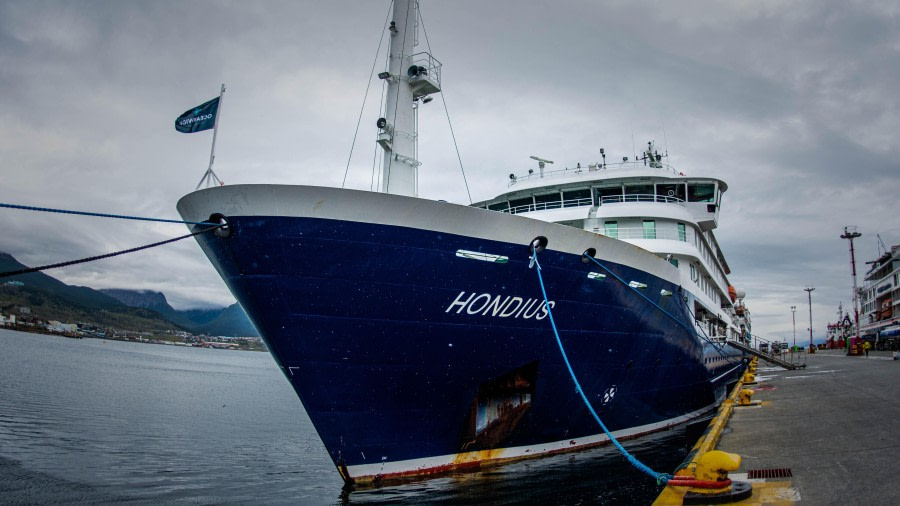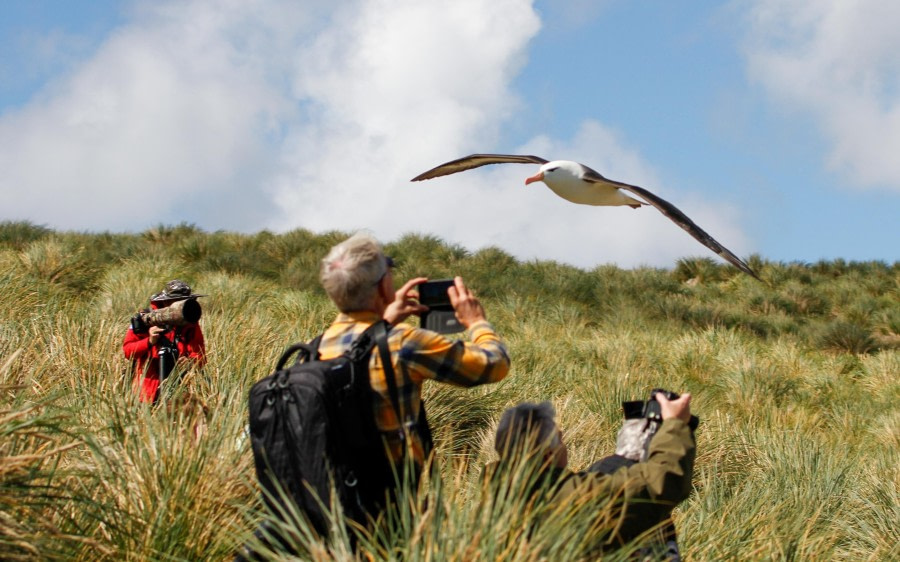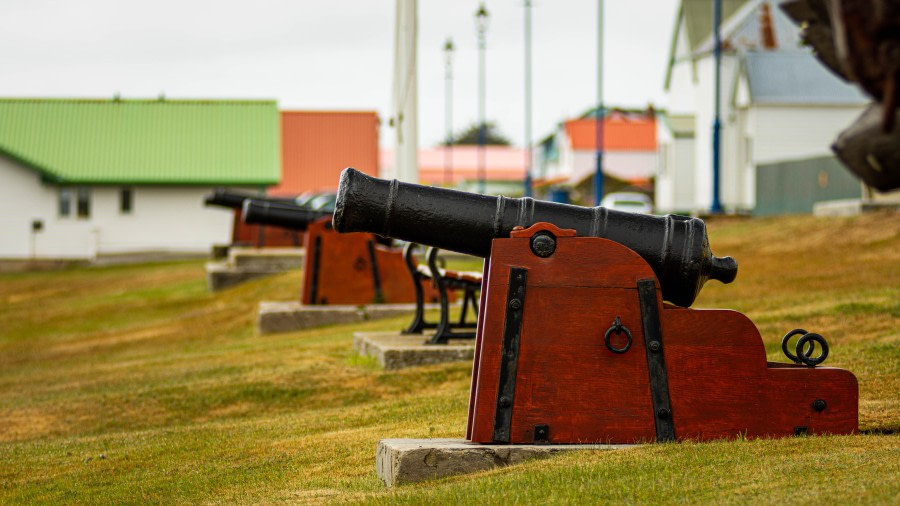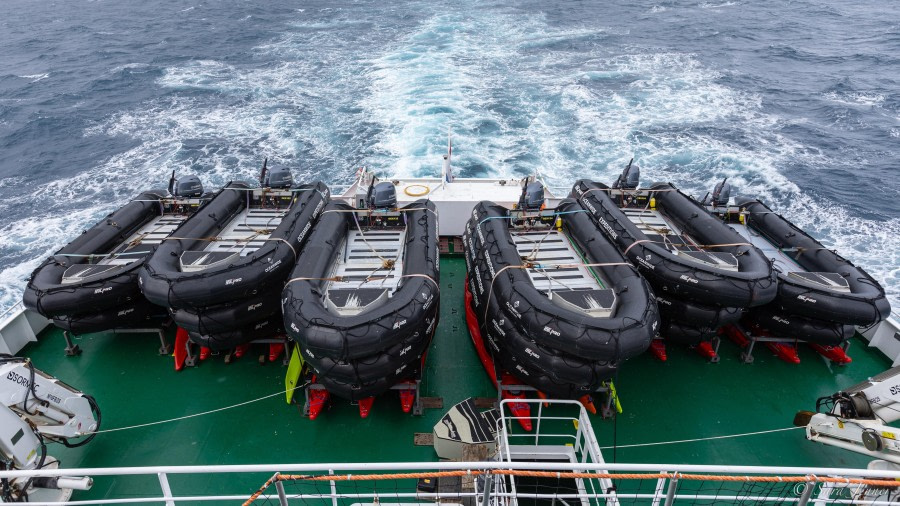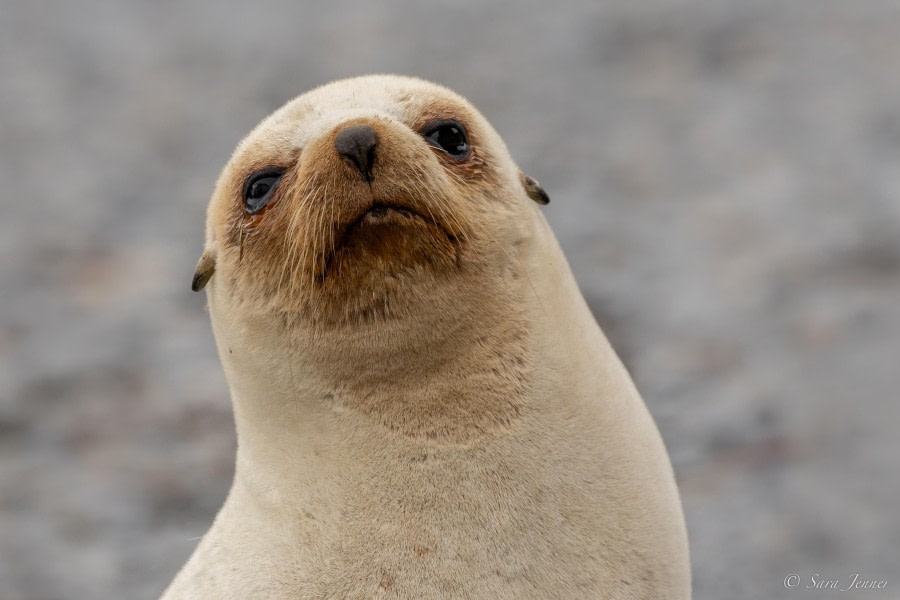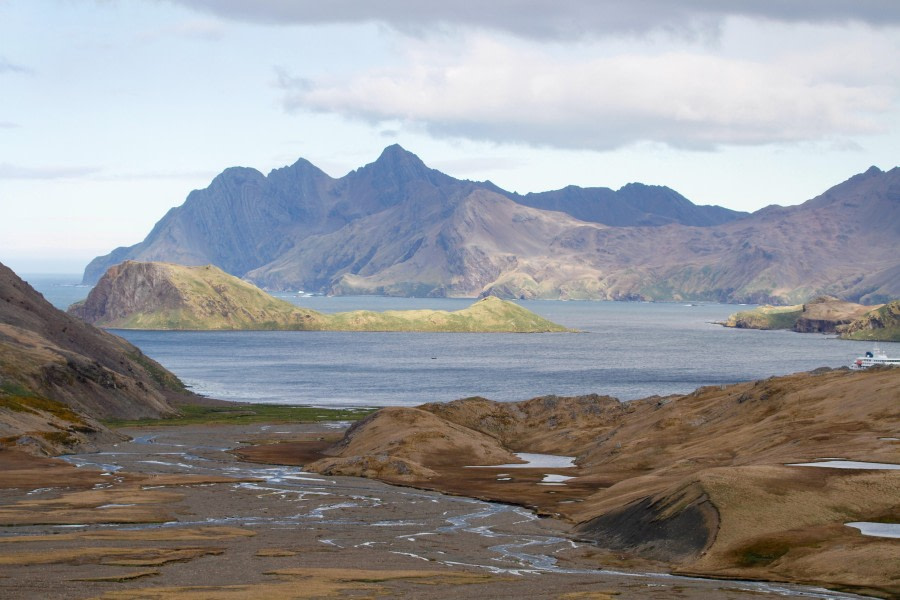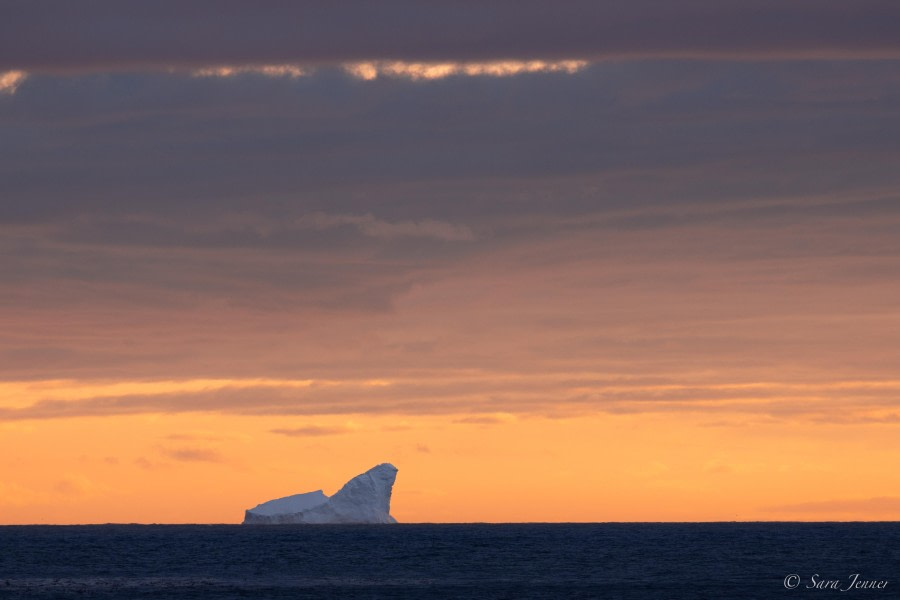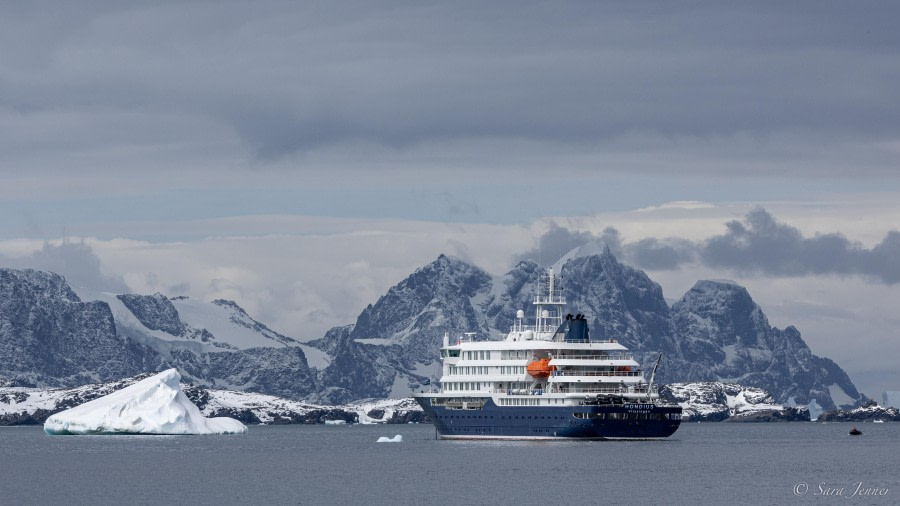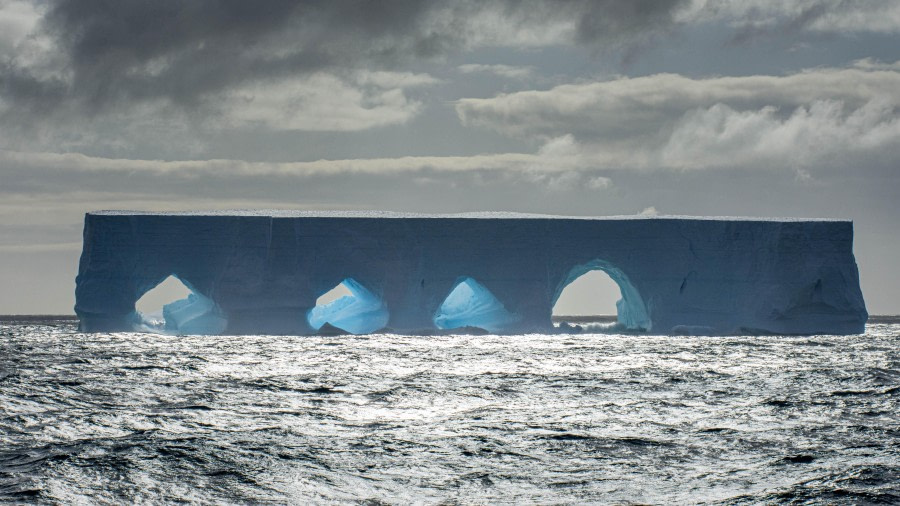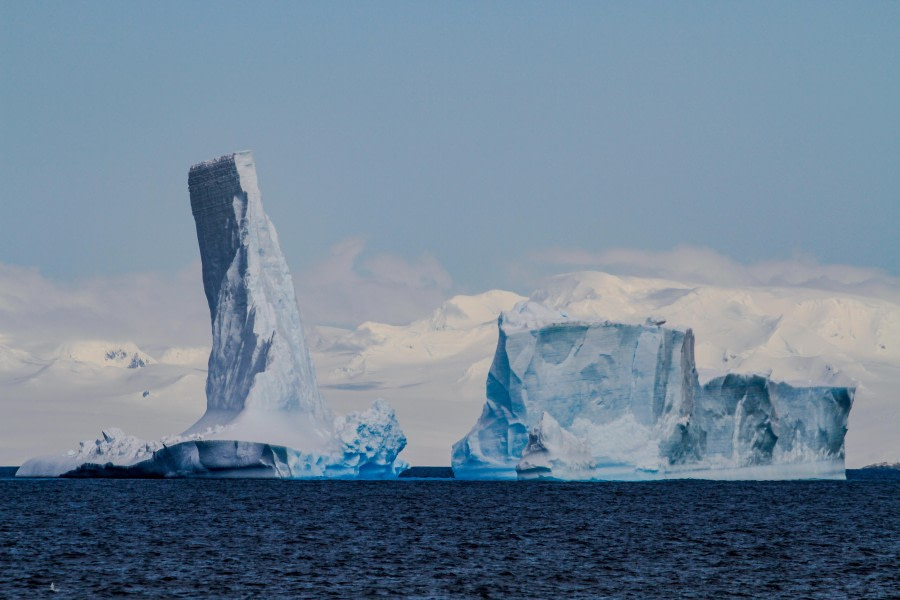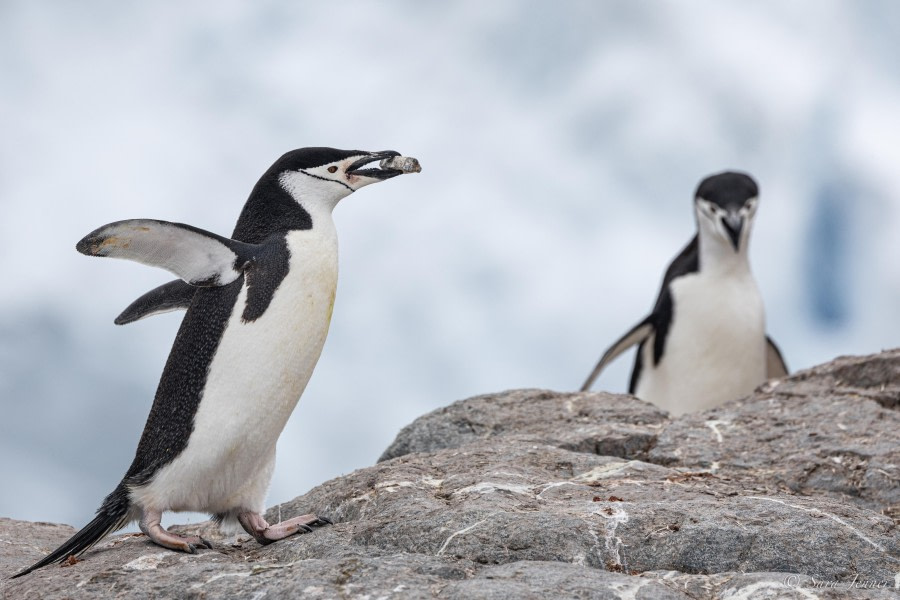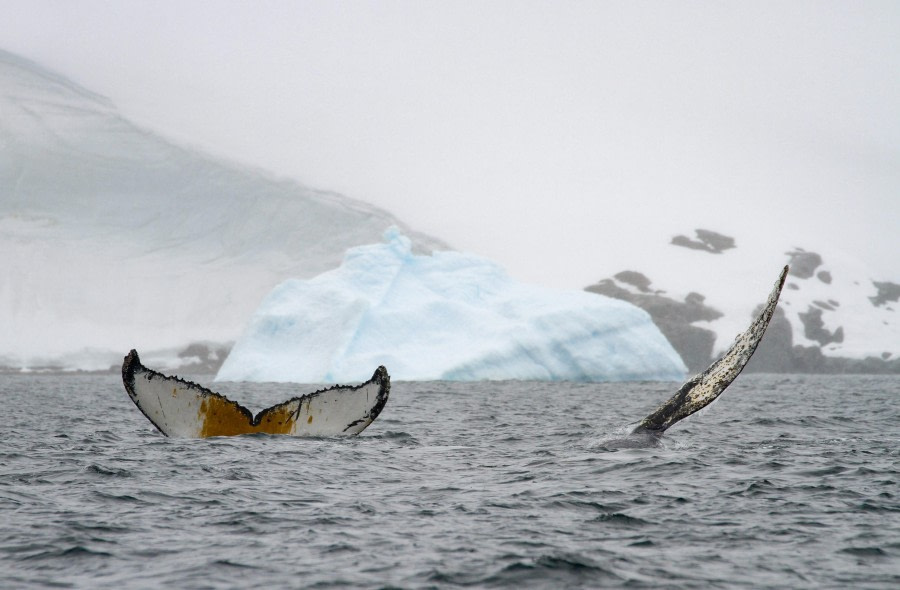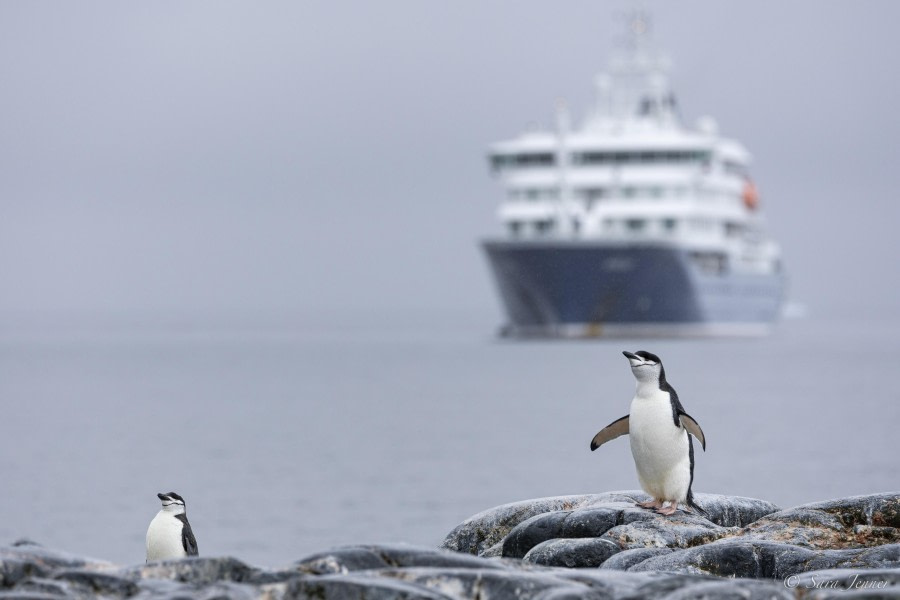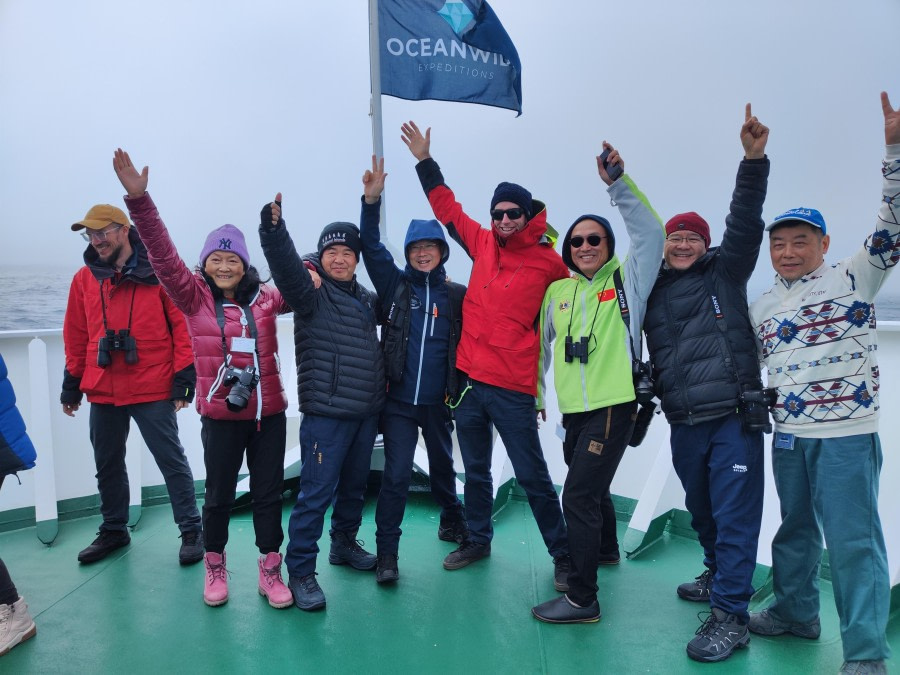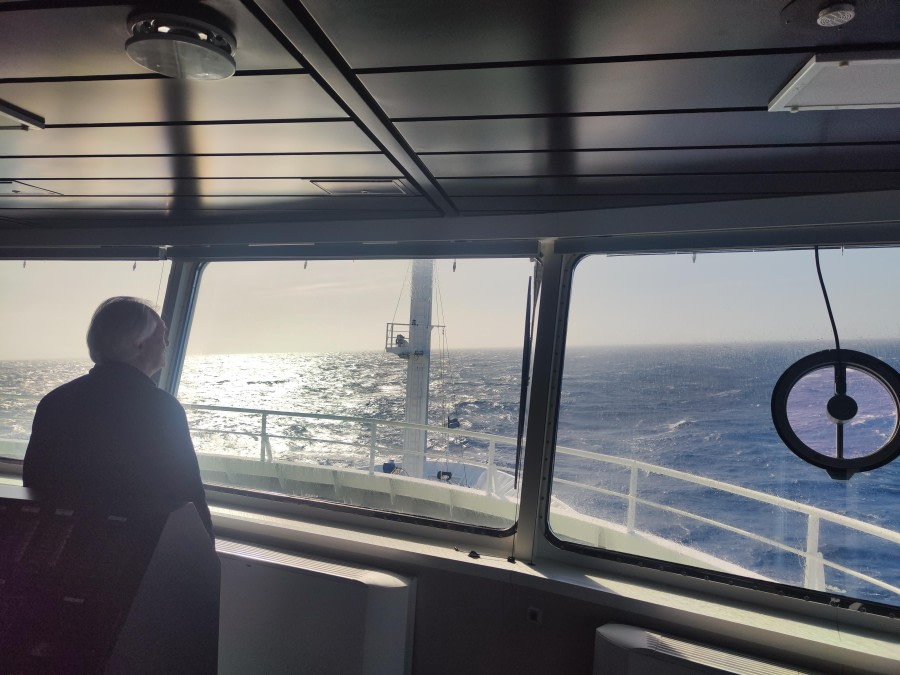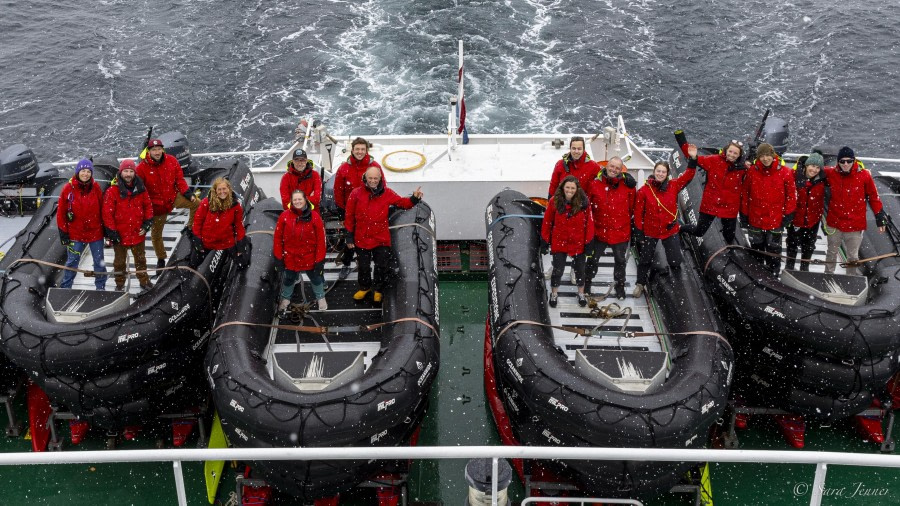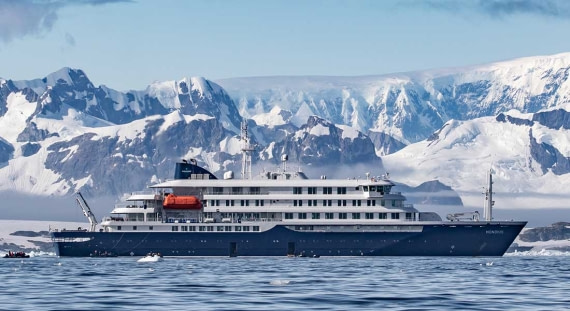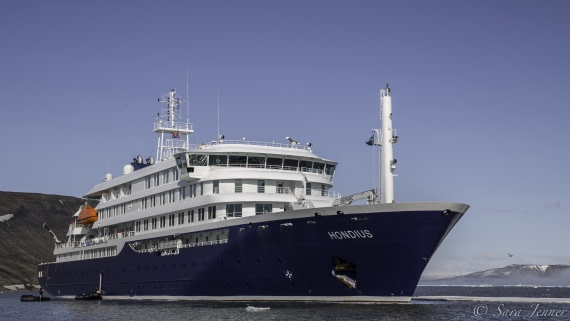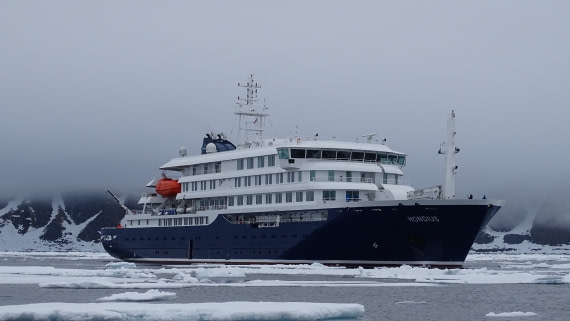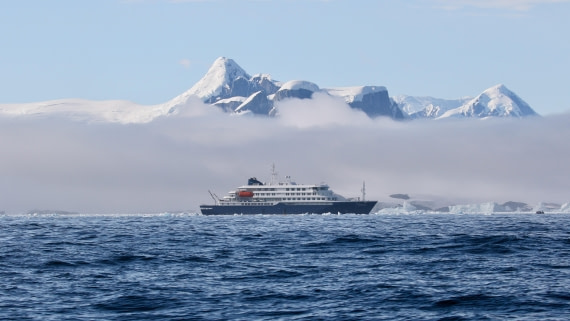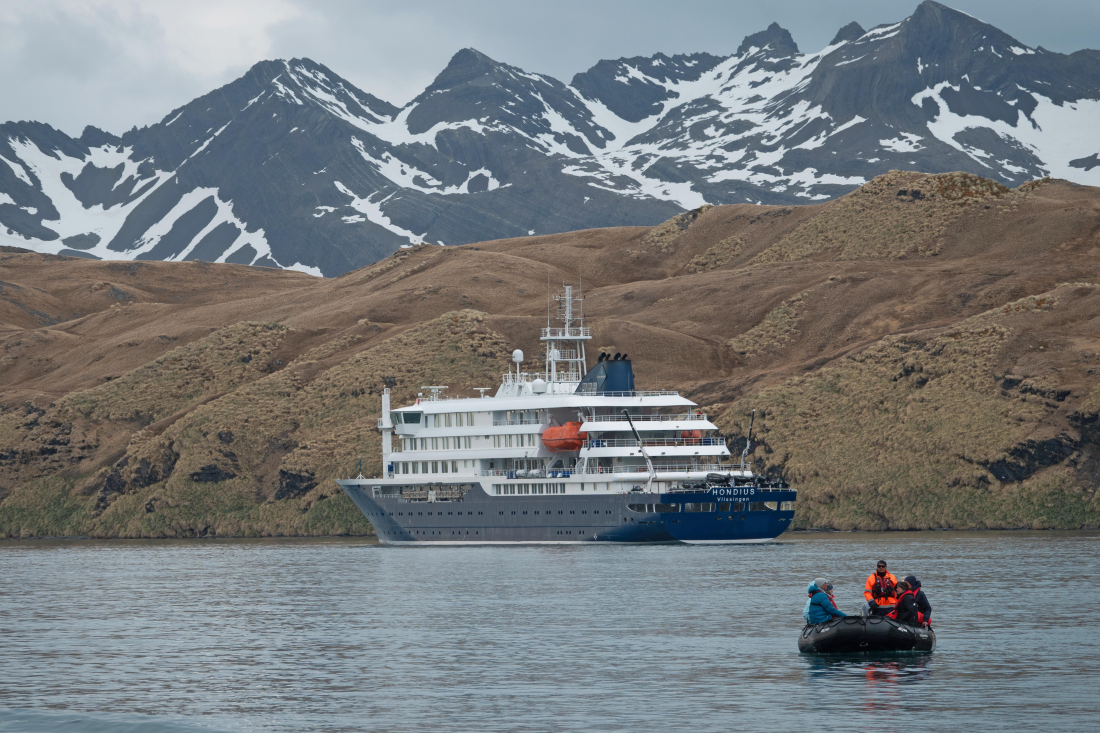| Datum: |
12.01.2024 |
| Positie: |
54°05,5' S / 036°36,2' W |
| Wind: |
W 3 |
| Weer: |
Duidelijk |
| Luchttemperatuur: |
+12 |
South Georgia koos ervoor om zijn toorn in te ruilen voor genade. Alsof het besloot dat de regenmuur die het de ochtend ervoor tegen ons had opgetrokken genoeg was, besloot het ons te trakteren op echt mooi weer. De zon speelde met glinsteringen op het gladde oppervlak van de zee, het polgras dat de kusten en talloze kleine eilandjes om ons heen bedekte, nog vochtig van de regen, levendig groen. Zuid-Georgische piepers dartelden heen en weer met uitbundig getjilp, overweldigd door vreugde. Een kwartier voor het ontbijt weerklonk de bekende roep van "Goedemorgen, goedemorgen, goedemorgen" uit de luidsprekers die in het plafond waren ingebouwd. Toen we het raam naderden en de gordijnen dichttrokken, was dat genoeg om te bevestigen dat het inderdaad een prachtige ochtend was!
De Hondius ging voor anker in Leith Harbour, tegenover het gelijknamige oude verlaten walvisstation. Een eeuw geleden was dit het grootste walvisstation in South Georgia. Zelfs nu, lang nadat het station werd verlaten, volledig in verval raakte en langzaam in stukken afbrokkelt, waarbij de natuur haar territoria weer opeist, ziet het er nog steeds indrukwekkend uit. Velen van ons hadden zich al voor het ontbijt aangekleed en stapten het open dek op om het panorama van Leith Station met zijn roestige pijpen, schoorstenen, enorme walvisoliereservoirs en scheve barakken en barakken, waar dappere walvisvaarders ooit hun toevlucht zochten, op foto vast te leggen. Leith Station heeft niet veel tijd meer om op zijn plaats te blijven staan. Antarctische winden en onophoudelijke regens scheuren als aaseters het karkas uit elkaar, waardoor deze ooit oase en voorpost van beschaving in de verre Antarctische breedtegraden geleidelijk in het niets verandert.
Een landing was gepland voor de ochtend. De avond ervoor hadden we afgesproken om ons in twee groepen op te splitsen: zij die hun benen wilden strekken en aan een drie uur durende wandeling door de vallei wilden beginnen, en zij die gewoon rustig langs de kust wilden wandelen en de plaatselijke fauna wilden observeren. De lange wandelaars arriveerden als eerste bij de zodiac boarding area, en het moet gezegd worden dat dat er nogal wat waren. Onze gidsen, die behendig door de kelpstruwelen navigeerden, brachten ze eerst allemaal aan land in Zodiacs, en toen was het de beurt aan degenen die niet uit waren op beweging maar op contemplatie.
De landingsplaats was een heel eind verwijderd van het walvisstation en dat was niet zonder reden. Bij de bouw van de faciliteiten werd actief gebruik gemaakt van asbest. Pas vele jaren later werd duidelijk dat asbest giftig is. Daarom geldt er nog steeds een uitsluitingszone van 200 meter rond het station, ook al is al het asbest al lang zorgvuldig verzameld en verwijderd. Bovendien kan een windvlaag op elk moment een losgeraakt stuk ijzer loswrikken, waardoor het neerstort op de hoofden van degenen die ongelukkig genoeg in de buurt zijn. .
De kust krioelde van leven! Overal waren grote aantallen pelsrobbenpups, die zich vrolijk en nog wat onhandig op hun flippers voortbewogen. Hoewel ze pas een maand of wat geleden geboren waren, hadden de pups al een typische strenge houding - ze gromden regelmatig naar ons en ontblootten hun kleine tandjes, alsof ze zeiden: "Kom niet dichterbij, vreemdeling, anders wordt het nog erger voor je! Moeders zaten ook overal verspreid, of het nu op het strand was, op de heuvels of in het gras, ze slaakten lange, huilende kreten in een poging hun kroost te lokken: "Kom sneller hier! Het is tijd voor de lunch! Mijn borstklieren zitten vol voeding!" Zodra de pups hun moeders gevonden hebben, begonnen ze onmiddellijk te zogen, loensen van plezier.
Bij een grote poel met stromend water, een verlengstuk van een kleine beek, op slechts enkele tientallen meters van de kustlijn, stonden Koningspinguïnen stil en geconcentreerd. Ze stonden daar met een reden - het was ruiperiode. Tijdens deze periode moeten de onfortuinlijke vogels gewoon op hun plaats blijven staan en wachten tot hun oude veren uitvallen en er nieuwe aangroeien. Tot dit gebeurt, kunnen pinguïns niet in contact komen met zeewater en kunnen ze dus ook niet jagen en voedsel voor zichzelf zoeken. We hielden afstand van hen en probeerden ze niet te storen.
Iets verderop, tussen de grasstruiken, lagen jonge zeeolifanten. Sommigen sliepen vredig, terwijl anderen ons verbaasd aanstaarden, hun kop optilden en ons met hun enorme, volledig zwarte ogen aankeken. Hun ouders waren allang naar zee gegaan om zich te voeden, inktvis en vis te vangen en hun kroost op de oever achter te laten. Sommige zeeolifantenpups waren, net als de pinguïns, in de rui, waarbij ze hun oude vacht afstoten en wachten tot de nieuwe groeit. Ze zagen er amusant uit tijdens dit proces.
De zon scheen fel. Ondanks onze gewoonte om ons warm aan te kleden, moesten we een paar onnodige lagen kleding afwerpen en in onze rugzakken stoppen. In omstandigheden waar het streng verboden was om iets op de grond te leggen of op te vouwen, was dit een hele uitdaging. We moesten op elkaar vertrouwen en om hulp vragen om een rugzak, jas of camera vast te houden.
Nadat we de eerste tweehonderd meter van de kust naar het binnenland van het eiland hadden afgelegd, bevonden we ons op een uitgestrekte weide bedekt met laag donkergroen gras. We moesten over kleine stroompjes stappen die speels van de berghellingen afdaalden. Ergens in het midden van deze uitgestrekte weide had een paartje jagers een nest gebouwd. Hun enige kuiken was al groot genoeg om rond het nest te lopen, maar de ouders bewaakten het nog steeds waakzaam, hielden de wacht en stonden niet toe dat iemand in de buurt kwam. Voor het geval dat, werd de wacht versterkt met Simon, onze ornithologische gids.
De grond in de weide was veen en stuiterde onder onze stappen, waardoor onze wandeling wat energie kostte. Aan het einde van het pad wachtte ons echter een mooi uitkijkpunt met uitzicht op het verlaten walvisstation van Leith. Talloze enorme tanks voor de opslag van blubber. Gigantische roestige cilinders met kegelvormige daken die op Vietnamese hoeden lijken. Het is angstaanjagend om er zelfs maar aan te denken hoeveel ongelukkige dieren er moesten sterven om deze gruwelijke opslagplaatsen te vullen. Maar dat is de prijs die de mensheid heeft moeten betalen voor haar wetenschappelijke en technologische vooruitgang. Nu we ons bewust zijn geworden van de realiteit, hebben we ons gehaast om walvissen te beschermen en ze op alle mogelijke manieren te bewaken. We kunnen alleen maar hopen dat dit besef tot ons is gekomen toen het nog niet te laat was. Het herstel van de walvispopulatie is een langzaam proces en stations als Leith, samen met andere walvisstations in South Georgia, kunnen tot stof vergaan voordat de walvispopulatie in de Zuidelijke Oceaan weer het oude niveau bereikt.
Iets naast het walvisstation markeerden kruisen en obelisken een kleine begraafplaats. Hier rusten degenen die hier ooit uit noodzaak naartoe kwamen, hun huizen en geliefde families verlieten in de hoop geld te verdienen en op de een of andere manier hun financiële situatie te verbeteren. Ze kwamen aan - en, hun krachten verkeerd inschattend, vielen ze ten prooi aan de harde natuur van deze plaatsen, gevaarlijk werk, ziektes en ongelukkige ongelukken. Echtgenotes zagen hun mannen nooit terugkeren en kinderen zagen hun vaders nooit. Een kort telegram in bureaucratische taal, samen met een kleine financiële vergoeding van de bedrijfsleiding, dat is alles. Slaap, vrienden, misschien leven degenen die de herinnering aan jou in hun hart meedragen nog.
Niet ver van de begraafplaats stond een groep ruiende Koningspinguïnen roerloos, alsof ze de overledenen herdachten.
Op de een of andere manier was het rond het middaguur tijd om terug te keren naar het schip. De lange wandelaars keerden terug van hun route. De Zodiacs, die zachtjes zoemden, brachten ons allemaal binnen een paar minuten terug naar de Hondius en we gingen blij naar het restaurant voor de lunch.
Terwijl we aan het eten waren, ging de Hondius voor anker en zette koers naar de naburige haven, waar een ander verlaten walvisstation genaamd Husvik aan de kust stond. We bereikten het vrij snel. Er waren geen geplande landingen aan de kust. In plaats daarvan organiseerde het expeditieteam een Zodiac cruise voor ons. Nadat we ons hadden omgekleed, gingen we in groepen van tien aan boord van de Zodiacs en met onze camera's in de aanslag vertrokken we om deze hoek van South Georgia te verkennen.
Husvik Bay was ondiep, begroeid met een kelpbos. Onze gidsen, die de Zodiacs bestuurden, moesten vaak de motoren optillen en de propellers uit de kluwen kelp halen. Desondanks was er volop leven in het kustgebied. Dezelfde Pelsrobbenpups onder de hoede van volwassen vrouwtjes, jonge zeeolifanten, Zuid-Georgische pinkenstaarteenden, pijpers, Kelpmeeuwen en Reuzenstormvogelen - niemand ontsnapte aan de lenzen van onze camera's.
Het walvisstation zelf was veel kleiner in omvang dan Leith, maar ook hier zagen we oude roestige tanks voor blubber, barakken voor het personeel en een met gras bedekte, halfvergane steiger. Een van de gebouwen, dat los stond van het station, zag er helemaal nieuw uit. Het was de zogenaamde Governor's Cottage, gerestaureerd door de regering van South Georgia en nu in gebruik voor haar doeleinden.
Iets naast de nederzetting aan de kust lag een kleine scheepsreparatiewerf, waar ooit reparaties en technisch onderhoud van de zogenaamde catchers plaatsvonden - kleine, snelle vaartuigen die walvissen harpoeneerden. Een van de boten stond nog steeds op de scheepshelling. Somber en droevig zag het eruit in de sfeer van de half verwoeste en verlaten scheepswerf. De enorme schroef had vier bladen. De houten kajuit op het dek was al lang vergaan en gekanteld; desondanks zagen de zijkanten van de boot er, hoewel roestig, nog behoorlijk fris uit. Het leek alsof de boot in verbijstering en afwachting stond. Waar was iedereen gebleven? En hoe zat het met haar? Misschien dacht het dat de mensen snel naar de werf zouden terugkeren, met schuurpapier langs de zijkanten zouden lopen, ze met verse verf zouden bedekken, de brandstoftank zouden vullen, de verbindingen en verbindingen zouden smeren, en het zou weer in de verte snellen, enthousiast door de reusachtige golven van de Zuidelijke Oceaan snijden... Nee. Niemand zal komen. Nooit. Het zal alleen op de scheepshelling staan tot de wind en atmosferische neerslag het uiteindelijk volledig vernietigen.
Een uur na de start van de Zodiac-cruise begon het weer helaas zijn onaangename en grillige aard te tonen. De wind stak op en boze, agressieve golven renden over het oppervlak van de haven, sloegen tegen de zijkanten van de Zodiacs en probeerden ons met zout zeewater te besproeien. Tegen die tijd hadden we alles al gezien wat de haven van het walvisstation van Husvik te bieden had, dus stuurden onze gidsen de boten naar het schip en keerden we veilig terug naar de Hondius.
De dag was nog niet voorbij. Voordat we definitief afscheid namen van South Georgia, stelden we ons ten doel om St. Andrew's Bay te bezoeken - misschien wel de meest legendarische plek op het hele eiland - bekend om de enorme kolonie van bijna 600.000 Koningspinguïnen. Daarnaast herbergt het zeeolifanten, pelsrobben, Reuzenstormvogels en vele anderen. Helaas bereikte dit jaar ongeluk South Georgia - een uitbraak van vogelgriep, die niet alleen vogels maar ook zeezoogdieren trof. De regering van South Georgia nam verschillende maatregelen om de verspreiding van de epidemie naar andere delen van het eiland te voorkomen, waaronder een verbod op landingen en Zodiac cruises langs de kust van St. Na enkele uren navigeren en manoeuvreren tussen enorme ijsbergen die door de stroming vanuit Antarctica werden meegevoerd, konden we de kust slechts naderen op een afstand van twee zeemijl. Toch was het genoeg om met een verrekijker de gigantische menigte pinguïns te observeren.
Het regende. Het leek alsof de natuur rouwde om de tragisch en voortijdig verloren wezens. De schemering overheerste terwijl de stralen van de laagstaande zon voor zonsondergang moeite hadden om door de dikke sluier van wolken te dringen. Met deze ietwat sombere noot kwam er een einde aan ons verblijf op dit betoverende eiland. De kapitein keerde het schip en terwijl de Hondius op weg ging naar Antarctica, begon het schip snelheid te maken. De kust van South Georgia bleef achter ons en loste langzaam op in de nevel van mist en regendruppels.
Vaarwel, South Georgia, wie weet komen we elkaar nog eens tegen. Dieren, herstel snel!
